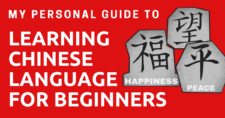
There is no question that China is a world power and Chinese is quickly becoming one of the most important business languages after English and Spanish. China might also be one of the most difficult countries to navigate without some level of local language ability, and doing business with Chinese speakers can be a minefield of lingual and cultural misunderstandings and miscommunications.
Whatever your reasons for wanting to learn, we applaud you. Learning a second language will make your life infinitely better. It will expand your employment horizons and grant you access to new groups of friends, new experiences, and new perspectives, allowing you to understand a whole new culture.
At this time in history, our whole world has been turned upside down by COVID-19 and we are finding new ways to live our lives. Online learning is safe, practical, sensible, and flexible. Right now, it makes more sense than ever to study online, and we want to help you make the best decision in your pursuit of education.
But which option is best for you? Are free resources enough or do you need more accountability than what free courses offer? In this guide we will explore, in depth, the platform ChineseClass101.
This article will take approximately 20 minutes to read. Don't have the time right now? No worries. You can email the ad-free version of the article to yourself and read it later!
Disclaimer: This article may include links to products or services offered by ExpatDen’s partners, which give us commissions when you click on them. Although this may influence how they appear in the text, we only recommend solutions that we would use in your situation. Read more in our Advertising Disclosure.
Contents
What is ChineseClass101?
ChineseClass 101 is an online Chinese language learning system created by Innovative Language Learning. Chinese is not the only language you can learn in this platform. They offer a total of 34 languages via their various web platforms and mobile app, which can be downloaded from the Apple App Store and the Google Play Store.
You can find the links by clicking on their main website. After you master Mandarin, you can choose to study Japanese, Thai, or French right after! The possibilities are endless.
The convenience of being able to study anytime and anywhere is the best part of ChineseClass101. The app and the website are synchronized and they both save your place, so you can easily log in from your phone sometimes and then on your laptop when you get back to your desk.
The flexibility that it offers was key to my personal learning journey. I find it so easy to use while riding the subway. It helps time fly, and makes me feel like I accomplished something during hours that I would normally idle away.
The progression of the lessons is logical and comprehensive. It is easy to jump in and out, even if you can’t finish the whole lesson in one sitting. The next lesson is readily available and easily accessible, and you can rest easy knowing that you will be presented with a comfortable step up with just the right amount of new vocabulary to tackle.
The lessons are based on real-world situations, or simple conversations which will help anyone navigate daily life in China or strike up a friendly conversation. A great feature is that each lesson can be downloaded as a PDF so that you can study offline and you can keep a record of your lessons in case you need a refresher in the future.
If you plan to move to China, you will have plenty of opportunities to practice your Chinese and have access to a broad selection of options to study the language formally. Before you get started, you might want to check out this guide to give you a better idea of what you are getting into.
What You Will Learn
Here’s what you will get from ChineseClass101.
Which Chinese?
It is recommended that learning Mandarin be your starting point in ChineseClass101. Most people in China speak Mandarin spoken in Beijing, which is known as Putonghua (普通话 Pǔ tōng huà). “Putong” means “standard” and “hua” means “language”.
Mandarin is the official language of China and Taiwan, and one of several languages spoken in Singapore, Hong Kong, Macau, and many other countries around the world like parts of Malaysia and, of course, within Chinese communities globally.
Note: Innovative Language Learning offers Cantonese classes as well via their CantoneseClass101 platform. If you are moving to Hong Kong or Macau, then it’s important that you choose Cantonese.
Writing
Written Chinese or Hanzi (汉子 Hàn zi) evolved into two forms: simplified and traditional. Traditional written Chinese consists of far more strokes in each character, which makes it more difficult to read and write. The majority of people in China can read Simplified Chinese.
ChineseClass101 has both simplified and traditional Hanzi available for you to see the difference.
Before you become comfortable reading Hanzi, ChineseClass101 will get you started with Hanyu Pinyin (汉语拼音 Hànyǔ pīnyīn), the official Romanized version of Chinese. Pinyin feels strange at first, but you will quickly get used to its sounds and the helpful tone marks that show you how to pronounce the word.
Grammar
The lessons in ChineseClass101 all come with grammar integrated into the dialogue transcripts and in the conversation between the two teachers. Most Chinese learners will tell you that the grammar is the easiest part of the language.
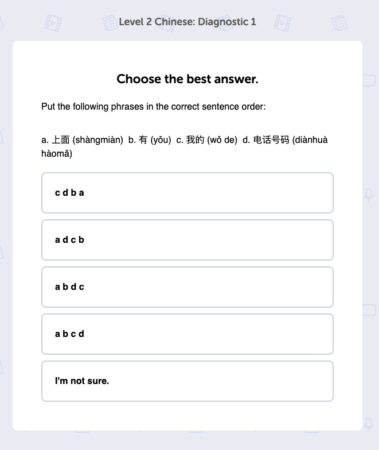
There are no masculine and feminine grammatical gender differences like in Spanish and almost no past/present/future tense stuff to worry about! You will get little tips and sentence structure notes as you go, and before you know it, the flow of Chinese sentences will start to come naturally to you.
Pronunciation
Being able to record your own voice speaking Putonghua and then comparing it to the ChineseClass101 recording of a native Chinese speaker pronouncing each word is a fantastic feature of this program.
Pronouncing Mandarin takes practice, so make sure you have time alone to say everything out loud. You might get funny looks if you try doing this part on the bus on the way to work.
Course Structure & Levels
Their lessons fall under five levels: Introduction, Absolute Beginner, Beginner, Intermediate, and Advanced. There are about 80 lessons in each course and each one comes with the main lesson followed by two to six assessments. These assessments include multiple choice tests, Hanzi reading practice, Hanzi writing, grammar practice, and vocabulary reviews.
Once you get up to Intermediate (Level 4) and Advanced (Level 5), the course is aligned with the HSK level 4 to 5. The HSK is the Chinese Proficiency Test (汉语水平考试 Hànyǔ Shuǐpíng Kǎoshì). This exam is the national standardized test for Chinese for non-native speakers of the language.
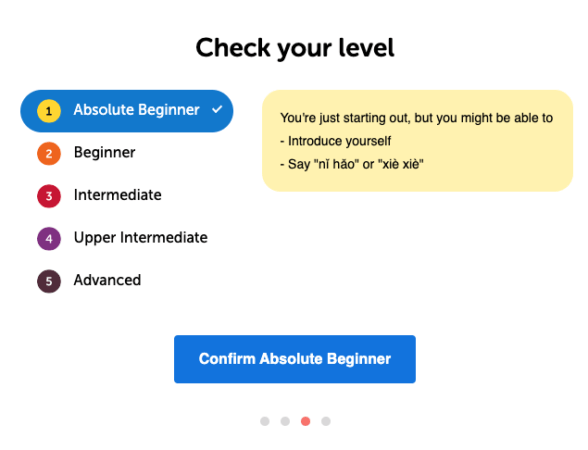
Having an HSK certificate can get you better job opportunities in China and give you access to Chinese university courses. For many learners of Chinese, passing the HSK with a high score is their main goal. The fact that ChineseClass101 was created with the HSK levels at its core is very important.
Absolute Beginner
Absolute beginner level one starts with “hello”, “where are you from?”, and other basic words and phrases. It is for someone with absolutely no previous experience speaking Chinese.
Beginner
Beginner level starts with short phone conversations with some focus on sentence structure (subject + time + predicate) and grammar.
Intermediate
With intermediate level, you will learn more nuanced conversations, small talk but with some niche vocabulary, and a more-than-average chat, or the type you would normally have with a cab driver.
This one is a good example of how level three expects you to be able to have more intimate conversations with Chinese friends
A: These seats are great.
B: I know. We’re right next to the stage.
A: Look…the lead singer looks really old.
B: Well…he is getting a bit old now.
A: And the drummer…is that a wheelchair?
B: They did start playing in the 1970s.
A: All of a sudden, I feel old.
Upper Intermediate and Advanced
Once you get to an upper intermediate level four you should be about to recognize about 1,000 Hanzi. By the time you finish advanced level, you should be able to read around 1,500 Hanzi. At the advanced level, the speakers in the sample dialogue are having in-depth conversations about mortgages, China’s interest rates, health, marriage, and other advanced topics.
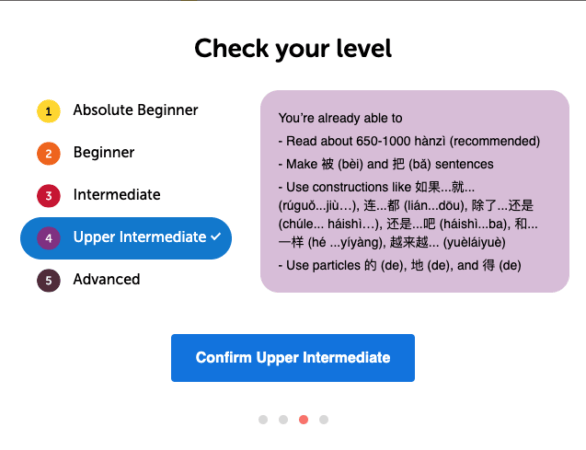
The good news is that even before you pay any money, you can try one lesson of each level after you do the assessment test. So if you do the assessment and feel you might have underestimated or overestimated your abilities, you can try the other levels to see where you really feel comfortable.
Another positive is that you are not stuck on one level. You can add all of the levels to your dashboard if you want and you can switch between them as often as you want. You are never stuck at a discouraging point that makes you feel uncomfortable.
Signing Up & Starting Out
Signing up in ChineseClass101 was super easy and, as advertised, I did not need to put in any payment or credit card information. I just provided my email and then activated it — the whole process took less than five minutes.
Once in, I was asked if I wanted the premium package for $1. If you do not choose to buy this offer right away, you will not see it again. The offer is worth $25+ and basically gives you a month of free premium.
After the first month for $1, you can continue with regular monthly payments of $25 or you can cancel. You are under no obligation to continue paying, so I do feel this is not a huge risk to take.
If you choose the $1 offer to sign up right away, they will also give you some other bonus products like an extra package of 50 lessons and some more premium content that is not normally included in membership.
However, I imagine most people want to do a trial before they put in credit card information, so I feel this one-time offer is probably under-utilized and kind of pointless. I did not select it myself and only realized its value after it was too late.
At first use, the website is smooth, intuitive, and free of any glitches. There is more functionality on the web version than in the app and I would strongly suggest getting started and signing up via the website first. Have a look around the lessons before you download the app and start using that; you might miss out on some features if you use the app exclusively.
One of the first things you have to do is the assessment test, which took around 20 minutes. It was quite comprehensive and it really tested my memory. I chose to start on level two because It has been about four years since I have spoken Chinese regularly.
These days, as I study Thai, I am scared that I am forgetting my Mandarin, so I was a bit unsure of my level. After several lessons, I gained back some confidence and realized that level two was a bit too easy for me, and I decided to challenge myself and go on level three.
Access & Pricing
Remember that you will have pretty much full access to the site as soon as you sign up and before you even make a payment, so take this opportunity to explore deeply. After the seven-day trial is up, you will start finding certain features locked.
You will only have full access to the first lesson of each level and you will have access to the audio of the first three lessons of each level but not the dialogue, vocabulary, or other features. So keep this in mind when you sign up, and make sure you have enough time to really dig in.
Even though all of the FAQ and other promotional writing for the site say that you CAN use it for free, I don’t believe it is of much value as a free user. This is the major con of ChineseClass101 for me. Although I appreciate that they want to provide some free learning, I do not see any value in what is provided for free.
It is for this reason that I would not recommend the course unless you are prepared to pay something. I do not think it is bad to have to pay for a high-quality product. Just as we do not expect good food or nice clothing to be free, we should also not expect people to produce fantastic software for free, either.
All that being said, the price is fair and very much within the reach of most learners.
For $4 a month (for two years) you can receive a Basic Plan. This will give you access to all lessons and the lesson notes. But you will miss out on a lot of features with this package. For $10 a month, you can get the Premium Plan.
In my opinion this is all you really need in order to learn Chinese. You get you access to almost everything that the program has to offer: quizzes, voice recording, vocabulary lists, full mobile access, and much more. You can see the list of features and the comparison of the three plans here.
For $25 a month, you can receive the Premium + Plan. This plan offers all of the goodies of Premium with added personalisation. This comes in the form of 1-on-1 teacher time. You can message a real-life Chinese instructor whenever you need someone to answer your questions and to practice lessons. You also get personalised lessons and assessments.

This is great if you are someone who needs a bit more accountability in order to reach your goals.
Now, these prices are all contingent on your signing up for two years. That is a pretty big commitment and I completely understand that you might not be able to meet that obligation. Luckily, you also have the option to sign up for a monthly, quarterly, half-yearly, or yearly basis. As with most deals, the price gets cheaper the longer your subscription.
If you are not ready to commit to a long-term course of study, you can get the one-month subscription for $8 for Basic, $25 for Premium, and $47 for Premium+. These prices are still reasonable considering you can study for as many hours as you want, especially compared to any of its in-person language school fees equivalent.
You can pay with a credit card, PayPal, or some other options if you email them directly to get more information.
Lesson Structure
For the purpose of this review, I will talk about Level 2 – Beginner. This is where I feel the majority of people will be placing themselves.
The first class is not intimidating at all. The pace and structure is perfect for beginners with some level of language exposure. The website is extremely intuitive and easy to navigate and, best of all, everything you need for the lesson is there on one page.
You can scroll around, stop and start the teachers’ dialogue for the lesson at any time, listen to certain words, then start the lesson from where you left off.
Each class consists of several elements. When you first get to the page, the first section is “Dialogue – Chinese”. Under the section heading are seven simple lines of Chinese dialogue in simplified Chinese characters.
You have sub-headings which allow you to see this same dialogue in English, Pinyin, or traditional Chinese character,s and you can flick between them as much as you like.
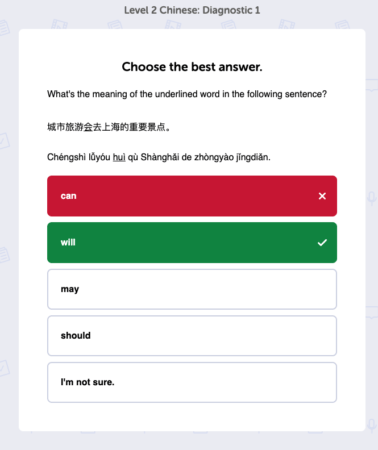
You can listen to each line of dialogue spoken by native Chinese speakers. You can also record your own voice line-by-line and compare it to the Chinese speaker. This REALLY helps with the tones. Remember that Putonghua has four tones and getting them right is of utmost importance.
The next section breaks down the vocabulary word-by-word. Again, you can listen to each word, try it at half-speed and also record your own voice. You can do these tasks as many times as you like until you get it right. This vocabulary is then provided in the form of flashcards, a slideshow, added to a word bank, and included in a quick quiz so that you can make sure you know each word before you even begin the lesson.
You will then find some lesson notes. This part is great for grammar nerds. I just love seeing the way different languages structure sentences, and knowing the way nouns and verbs interact in comparison to English really helps. In this section, they will tell you things you need to know about the dialogue, like the fact that adding the particle 吗 (ma) to a verb turns the verb into a question.
These little key pieces of information will help you wrap your head around the language faster than just trying to memorize vocabulary.
The final part of the lesson is the downloadable lesson transcript and the audio recording of the lesson. This is a conversation between two people, one is a native Chinese speaker and the other is a North American woman. I found their voices pleasant, easy to understand, perfectly paced, and enjoyable.
I was not bored and it was not cheesy the way other language learning platforms present. We are not children after all, so I appreciated their lighthearted but direct and accurate methodology.
The audio lesson was 14 minutes long and just right to memorize the dialogue with a bit more context added. The teachers take the dialogue’s language and give you examples of other situations in which that vocabulary can be used. Their banter is fun and clear and does not linger too long over every point. I felt very comfortable with the lesson length and the way they put grammar into context.
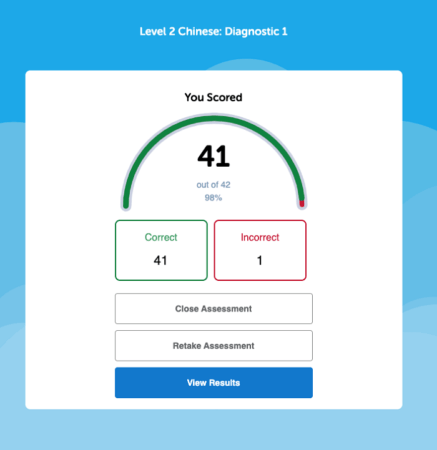
Once you finish the lesson, you can do your quizzes and other assessment tasks. You can also come back at another time to finish them which helps refresh and solidify your new knowledge.
I also really loved the comments section under each lesson. Here you can put your questions or feedback, and the administrator is right there to respond, help, or simply thank you for your input. It made the lesson more interactive and made you feel a bit more like a part of a class rather than a solo learner.
Is It Worth It?
ChineseClass101 is an affordable and convenient option for anyone who wants to study Putonghua. As with any kind of learning, it does take discipline and self-motivation to make it work.
Signing up is not going to magically get you speaking Mandarin in a few months, and if you are the kind of person who lacks that inclination to buckle down and do the work, then you might be better off in a real world classroom. But if you are incentivized enough and are a good solo learner, then this is definitely one of the best programs on the market.
Whether you are just beginning your journey or you are finally getting serious enough to take the HSK exam, the accessibility and adaptability of ChineseClass101 makes it perfect for every level of student. Considering you can get their Premium plan for only $1 for the first month when you sign up which you can cancel at any time, there is no risk in taking the leap.
After looking into the comprehensive resources provided for you, we truly feel that this subscription is one worthy of your money. For some people, the simple act of actually paying for a program becomes the right incentive they need to follow through and keep up with the work.
Personally, I just don’t feel that any of the free resources out there provide students with the solid foundation, quantity and variation of lessons and levels, and encouragement needed to tackle the epic task of learning a second language.
Stay motivated, consistent, and steadfast, or as the Chinese folks would say: “加油!!” (jiā yóu). Don’t worry, you will know what that means in no time!


